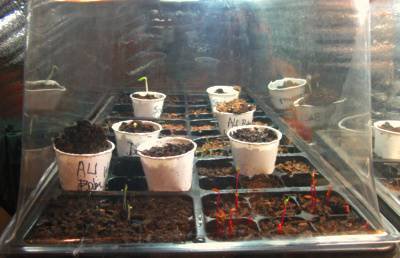|
Starting Seeds for Your Vegetable GardenDuring those long winter months, we gardeners look forward to starting seeds for our gardens. There are several ways to accomplish this that work well. So for the experienced gardener or the beginner, getting a head start on the gardening season by starting seedlings indoors gives you a longer growing season. Who doesn't want to take that first bite of your home grown tomato as early in the season as possible, right? I am not fond of unnecessary work, and I'm sure you don't like it either. So you will appreciate a simple way to determine the right time and the most efficient way to get a head start on your garden this year. Which way you choose will depend on your climate, your garden's size, and your budget.
Garden Facts to ConsiderMy garden is not particularly large. I live in a very hot climate, and we have only a short season before the sun begins to fry the spring vegetables. In order to get tomatoes that will ripen before the sizzling temperatures in the second half of June, I have to get my tomatoes, peppers, and squash in the ground as close to the last frost date for my area as possible. The last frost date is an average, so you will want to put out less tender items in the first week or two. Plants like peas, onions, lettuce, parsley, beets, turnips, carrots, broccoli, cabbage, and other cold hardy vegetables will take a light frost with no trouble. Give them a week or so of hardening off before planting, and they will do well. Two weeks or more after the last frost date for your area will be soon enough for squash, cucumber, peppers, tomatoes, beans corn, okra, and melons. If you plant them in the ground directly, then 10 days after the last average frost is a safe bet. Starting Seedlings IndoorsIf you read the packets for your seeds, you will see that most of them will tell you to start the plants 4-8 weeks before the last frost date. This should have them at the right stage to be transplanted into the garden just after the last frost hits. Most plants transplant better if they have not developed a lot of leaves yet. Just 4-6 true leaves is usually the best time. I tend to go with the shorter 4 weeks, 6 at most.The growth of your seedlings will depend on the temperature, the amount of light they get, and the moisture. If they grow in the house for too long, they might get tall and spindly. That can make transplanting them difficult. Not just for you, but for the plant as well, because long skinny stems get bent much more easily. Most plants don't do well if their main stem gets crimped or bent, and rarely survive. If they do start getting leggy, then you will need to give them more light. The indoor lights should be no more than 8 inches above the seedling tray. If they still get leggy, then you may want to consider putting them outside in the sun during the warmest part of the day, and then back under the indoor light so that they get 12 hours of light. They need 12 hours of darkness too, so don't go beyond the 12 hours of light.
|








